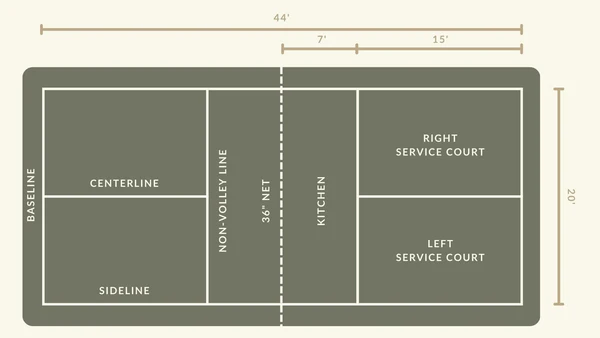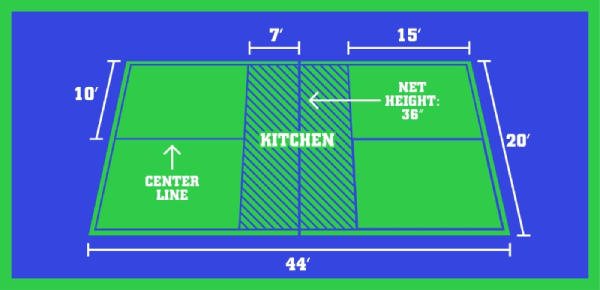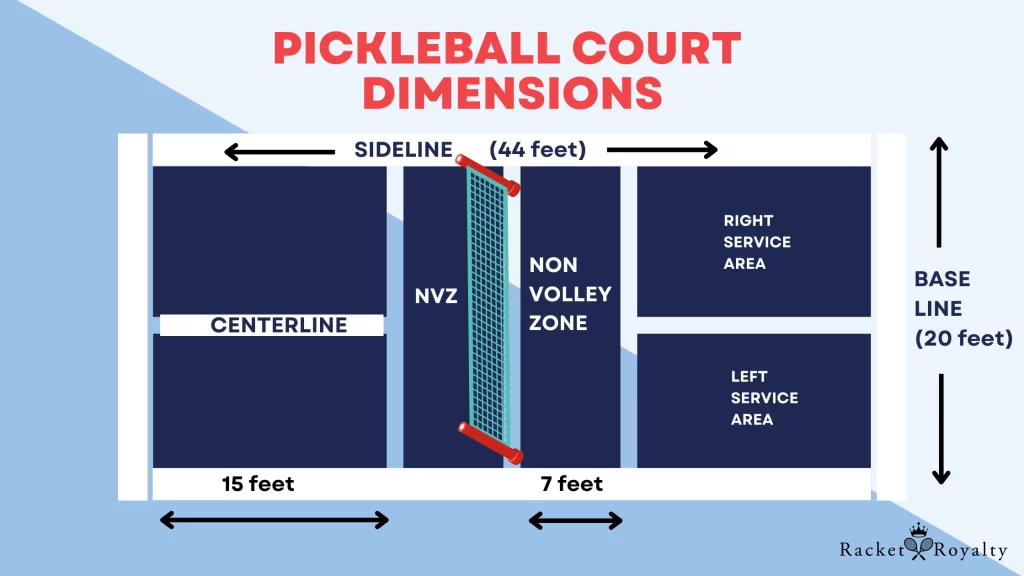Whether you’re new to pickleball or a seasoned player brushing up on fundamentals, understanding how big is a pickleball court is crucial. Court dimensions directly influence your positioning, strategy, and overall gameplay. In this article, we’ll break down the size, structure, and layout of a pickleball court, comparing it to other sports and explaining what each zone means for your performance on the court.

Content
Why Understanding Pickleball Court Size Matters
Pickleball is one of the fastest-growing sports in the U.S., and for good reason—it’s fun, accessible, and easy to learn. But mastering it starts with knowing the exact dimensions of a pickleball layout in feet. Knowing the court layout gives players better spatial awareness, helps improve footwork, and enhances shot accuracy.
Whether you’re setting up a court or trying to gain a competitive edge, understanding the official pickleball Ground size is a must.
Official Pickleball Court Size in Feet

So, how many feet is a pickleball court exactly? According to USA Pickleball, the official pickleball court size is:
- Length: 44 feet
- Width: 20 feet
These dimensions apply to both singles and doubles play. Unlike tennis, which has separate court sizes for singles and doubles, pickleball keeps it consistent. This simplicity makes the game easier for newcomers and keeps gameplay uniform.
The court is also surrounded by a recommended minimum of 10 feet of clearance on each side to allow safe movement and avoid hazards like fences or walls.
How Does Pickleball Court Size Compare to Other Sports?
To better understand the scale, let’s compare a pickleball court to courts from other racquet sports:
- A tennis court is 78 feet long and 27 feet wide (for singles), which is significantly larger.
- A badminton court measures 44 feet long and 20 feet wide—exactly the same as a pickleball Ground.
Interestingly, pickleball Ground can even be created on existing tennis courts. You can fit up to four pickleball courts within a standard tennis court space, which makes shared recreational spaces highly efficient.
Key Areas of a Pickleball Court
A standard pickleball Ground includes several important zones that affect gameplay:
1. The Non-Volley Zone (aka “The Kitchen”)
- This 7-foot area on either side of the net is called the non-volley zone.
- Players are not allowed to hit the ball in the air while standing in this zone.
- It’s designed to prevent overpowering net play and encourage finesse.
2. Service Areas
- The court is divided into two equal service areas on each side, measuring 10 feet wide and 15 feet deep.
- Players must serve diagonally into the opposing service box.
- Understanding service zones helps avoid faults and improves serve placement.
3. Baseline and Sidelines
- The baseline marks the back boundary of the court.
- The sidelines define the left and right boundaries.
- Together, they establish the pickleball Surface length and width, creating the outer limits of play.
4. Centerline
- The centerline runs from the baseline to the non-volley zone and divides the service boxes.
- It’s important during serves and helps with positioning during doubles play.
Pickleball Court Dimensions in Feet: At a Glance

Here’s a quick reference guide to the dimensions of a pickleball Surface in feet:
| Court Feature | Measurement (Feet) |
| Total Court Length | 44 ft |
| Total Court Width | 20 ft |
| Non-Volley Zone (Kitchen) | 7 ft |
| Service Area (each) | 10 ft x 15 ft |
| Net Height (center) | 34 in |
| Net Height (sides) | 36 in |
This clear and compact layout ensures fair gameplay, no matter the level of competition.
Court Surface and Net Specifications
The surface of a pickleball Surface is typically asphalt or concrete, coated with a textured acrylic to reduce slipping. The net stands 36 inches high at the posts and dips to 34 inches in the center. These measurements encourage fast rallies while maintaining fairness for players of all ages and skill levels.
How to Mark a Pickleball Court
If you’re converting a driveway, gym, or tennis court into a pickleball Surface, the key is proper measurement. Use chalk, tape, or temporary court kits to outline:
- 44 ft by 20 ft playing area
- 7 ft non-volley zones from the net
- Equal service areas divided by a centerline
Be sure to maintain symmetry on both sides of the net. It’s recommended to use a measuring tape and court stencil to ensure regulation accuracy.
Indoor vs Outdoor Pickleball Court Dimensions

Good news: pickleball Area dimensions in feet remain the same whether you’re playing indoors or outdoors. However, the environment can influence:
- Surface texture and ball bounce
- Lighting conditions
- Wind resistance (outdoor)
When setting up an outdoor court, allow for additional buffer zones for safety and accommodate space for spectators or extra players.
Tips for Players: Why Dimensions Matter
Understanding the pickleball Area length and width can give you a real advantage:
- Plan better shot angles, especially in doubles
- Avoid stepping into the non-volley zone during volleys
- Stay inside the sidelines and avoid out-of-bounds calls
- Improve footwork by anticipating where the ball can land
Knowing how many feet is a pickleball Area helps players predict movement and play with confidence.
Conclusion
The next time you step onto a court, remember that its dimensions are more than just numbers—they’re the blueprint for strategy, safety, and success. Whether you’re just curious or planning to build your own court, knowing how big is a pickleball Area gives you the clarity to play smarter and stronger.
By understanding every inch—from the non-volley zone to the baseline—you’ll be well on your way to mastering the game. Check out our guide to the best pickleball paddles for beginners to find the perfect paddle to start your game with confidence.
FAQs
Q1: Can I fit a pickleball court in my backyard?
Yes! A pickleball court is relatively compact at 44 feet by 20 feet, making it one of the most backyard-friendly sports courts. Just ensure you have extra space around the edges for movement.
Q2: Are there different dimensions for singles and doubles play?
No. The official pickleball court size remains 44 feet long and 20 feet wide for both singles and doubles. The rules and court layout do not change.

Emily Harris is your ticket to the sports world. From thrilling competitions to heartwarming sportsmanship, she’s got you covered with her extensive sports insight.
